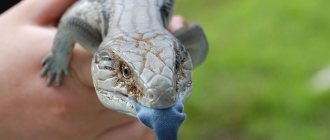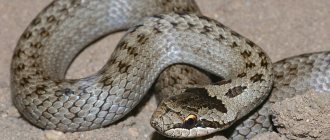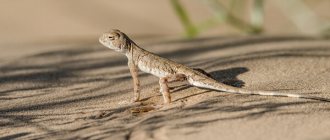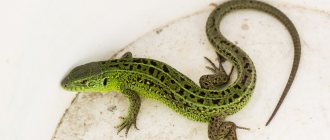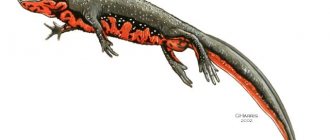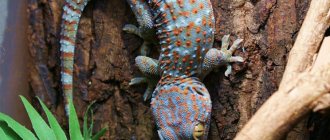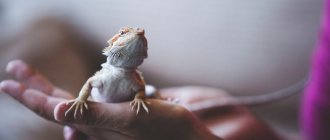In the tropical rainforests of the southern hemisphere of our planet, there are thousands of species of diverse fauna. The most exotic species of mammals, amphibians and birds live here. Their most striking representative is the dragon lizard. This is a small reptile with wings that, upon closer inspection, closely resembles the main character of Chinese folklore.
The flying dragon has a relatively small body
External signs of a flying lizard.
The flying lizard has large “wings” - leathery outgrowths on the sides of the body. These formations are supported by elongated ribs. They also have a flap, called a dewlap, which is located under the head. The flying lizard's body is very flat and elongated. The male is about 19.5 cm long and the female is 21.2 cm long. The tail is about 11.4 cm long in the male and 13.2 cm in the female.
Common flying dragon, flying lizard - representative of agamidae
Dracos is distinguished from others by rectangular brown spots located on the upper part of the wing membranes and black spots below. Males have a bright yellow dewlap. The wings are bluish on the ventral side and brown on the dorsal side. The female has slightly smaller dewlaps and a bluish-gray tint. In addition, the wings on the ventral side are yellow.
Reproduction of a flying lizard.
The breeding season of flying lizards is believed to be between December and January. Males and sometimes females exhibit mating behavior. They spread their wings and shake their whole bodies when they collide with each other. The male also fully spreads his wings and in this state circles the female three times, inviting her to mate. The female builds a nest for the eggs, forming a small hole with her head. There are five eggs in the clutch; she covers them with earth, compacting the soil with the clap of her head.
The female actively guards the eggs for almost a day. Then she leaves the clutch. Development lasts about 32 days. Small flying lizards can fly right away.
Habitats
The small, harmless reptile is found near the equator and in southeast Asia.
Reptiles live in a number of countries
Its natural habitat includes:
- Myanmar;
- India;
- Southern China;
- Kalimantan Island (Borneo);
- Malay Islands;
- Indonesia and the Philippines;
- Bangladesh;
- Eastern part of Vietnam and Thailand.
The flying lizard prefers places far from cities and villages. That is why it is difficult for a person to meet this exotic animal in the wild.
Flying lizard behavior.
Flying lizards hunt during the day. They are active in the morning and afternoon. At night, flying lizards rest. This life cycle avoids the daytime period with the highest light intensity. Flying lizards do not fly in the full sense of the word.
They climb onto tree branches and jump. When jumping, lizards spread their wings and glide towards the ground, covering a distance of about 8 meters.
Before flying, lizards turn their heads down towards the ground, gliding through the air helps lizards move. Lizards do not fly during rainy and windy periods.
To avoid danger, lizards spread their wings and glide downwards. Adults are extremely mobile and very difficult to catch. When the male encounters other lizard species, he displays several behavioral responses. They partially open their wings, vibrate their bodies, and 4) fully open their wings. Thus, males try to frighten the enemy by demonstrating enlarged body shapes. And the female is attracted by her beautiful, spread wings. Males are territorial individuals and actively protect their area from invasion, which usually has two or three trees and is home to one to three females. Female lizards are obvious candidates for mating. Males defend their territory from other males who do not have their own territory and compete for females.
Variety of species
Scientists know about thirty species of winged lizards. Among them the main ones are:
- ordinary;
- reticulate;
- spotted;
- bloodbeard;
- five-way;
- Sumatran;
- horned;
- Blanford.
All flying agama lizards are united by the presence of wings. They differ from each other in size, habitat and different colors. The color palette is determined by the color of the surrounding nature.
Sumatran lizard
Unlike other representatives of its kind, it prefers abandoned parks and degraded forest areas near human habitation. Not found in wild jungles or remote areas.
Maximum body length is 9 cm.
They are the smallest of the flying dragon family. The body length is only nine centimeters , the color is gray or brown almost indistinguishable from the bark of the trees on which they live.
Horned dragon
A unique species that lives on the island of Kalimantan. Includes two populations. One of them lives in mangroves, the other prefers lowland rain forests. A remarkable feature of horned lizards is their ability to camouflage themselves as falling leaves. The mangrove dragon has red membranes, while its relative has green membranes with a brown tint.
Imitation of falling leaves allows animals to float freely in space without fear of attack by birds of prey. According to scientists, reptiles do not use their camouflage for communication. Individuals that have migrated to other forest zones acquire an adaptive membrane color. In any place where they live, they imitate leaf fall.
The ability for divergent evolution distinguishes the miniature lizard from many representatives of the fauna of our planet. Nature gifted them with the ability to fly and camouflage as the only way to survive in the harsh conditions of the wild jungle.
In this video you will learn more about the little dragon:
Why can lizards fly?
Flying lizards have adapted to living in trees. The color of the skin of flying dragons is monochromatic green, gray-green, gray-brown, merging with the color of the bark and leaves.
Skeleton of Draco volans
This allows them to remain invisible if the lizards are sitting on branches. And the bright “wings” make it possible to soar freely in the air, crossing space at a distance of up to sixty meters. The spread “wings” are colored in green, yellow, purple shades, decorated with spots, specks and stripes. The lizard does not fly like a bird, but rather plans, like a glider or parachute. For flight, these lizards have six enlarged lateral ribs, the so-called false ribs, which, when expanded, extend a leathery “wing”. In addition, males have a noticeable fold of bright orange skin in the throat area. In any case, they try to demonstrate this distinctive feature to the enemy, sticking him forward.
Flying dragons practically do not drink; they compensate for the lack of fluid from food. They easily detect the approach of prey by ear. For camouflage, flying lizards fold their wings when sitting in trees.
The color of the body covers blends with the background of the environment. Flying reptiles glide very quickly, not only downwards, but also upwards and in the horizontal plane. At the same time, they change the direction of movement, dodging obstacles that arise along the way.
Features of nutrition and reproduction
The winged lizard is known to eat insects. Their menu includes:
- wood ants;
- beetles and butterflies;
- termites;
- insect larvae.
Leading a sedentary lifestyle, the flying dragon lizard can wait for hours for prey to appear. As soon as this happens, the reptile catches and swallows the victim, without changing its body position.
The dragon feeds on various butterflies.
While hunting for flying insects, it glides between branches and catches prey. Grabbing it with his teeth, he returns to the tree and eats it. The necessary liquid is obtained from food, so the reptile does not need water. Among natural enemies, the main ones are birds of prey and snakes, from which the lizard hides, merging with the environment.
The flying dragon is an oviparous lizard. During the mating period, the male inflates his bright folds, thereby demonstrating to the female his beauty and readiness for procreation. The female lays two to four eggs. To protect them from predators, she buries them in small holes dug in the soil. Masks the nest with leaves and dirt. She is helped in this by her pointed nose, specially adapted for such manipulations.
The reptile guards the clutch for one day, after which it returns upstairs. After a few months, the cubs hatch, ready for independent life and with the ability to fly.
The hidden lifestyle does not allow scientists to thoroughly study the lizard. It is not yet known how many babies are born to one individual, as well as how long they live. But the number of these animals is not critical, and they do not fall under the status of protected animals.
Description
The flying lizard is an inconspicuous animal that blends very well with the tree on which it lives. Stealth is primarily due to its small size. The length of the lizard ranges from 20 to 40 cm. Most of the body length is a thin tail, which, among other things, performs the function of turning during flight. The body is narrow and can reach 5 cm in thickness.
A distinctive feature of this lizard from others is the small corrugated folds on both sides of the body. They are attached to false ribs and spread during flight, forming wings. Males have a special fold located on the throat that helps stabilize their position during flight. In addition to helping during flight, the gular fold serves to attract females and scare away opponents.
The second element that preserves their invisibility on trees is their brown-gray color with a metallic sheen, which allows them to blend not only with the trees, but also with the surrounding landscape. The side membranes on both sides are painted in bright colors that alternate one after another. The colors on the upper side shimmer in the color scheme - red, yellow, with various inclusions - spots, stripes and specks. On the bottom side you can see this picture: yellowish and bluish color here, connected with dots of different colors. Speaking about color , one cannot fail to mention the bright colors of the animal’s tail, legs and abdomen.
Natural enemies of agamas
Photo: What does an agama look like?
Among the main enemies of these lizards:
- snakes;
- mongooses;
- large birds.
For birds, the fact that agamas bask in open areas, and usually on a hill, is extremely convenient; it is easy for them to look out for prey from a height and dive onto it. Agama, with all her speed and dexterity, does not always manage to elude the bird, and this is her only hope - she has no chance of fighting back. Their bright colors help birds search for agamas - combined with their love of lying on a clearly visible open point, this makes the agama one of the most easily accessible prey, so birds kill them more often than any other animals.
But they also have enemies among other reptiles, primarily snakes. Here the outcome of the fight may not be so clear, and therefore the snakes try to sneak up on the lizard unnoticed, make a sharp throw and inflict a bite - the poison can weaken or even paralyze the agama, after which it will not be difficult to deal with it. But if she notices a snake, she can run away from it - the agama is faster and more agile, or even inflict serious wounds with her claws if the snake is not very large.
She may even be forced to escape from an overly dangerous lizard, and moreover, it is rare, but it happens that an agama feasts on a snake. Mongooses are not averse to eating both agama and snake - the agama’s agility is not enough against them. Here, as with birds of prey, all she can do is take flight.
In the kingdom of flying dragons
Vladimir Bobrov, Candidate of Biological Sciences,
Institute of Ecology and Evolution named after.
A. N. Severtsova RAS (Moscow) “Nature” No. 8, 2016
"Wings" of the Indochinese flying dragon ( Draco indochinensis
). Photos by the author here and below
Making my way in the very center of the Vietnamese tropical forest through a tangle of vines under the continuous ringing of cicadas, invisible in the dense crowns, I carefully examined the thickness of foliage and branches surrounding me in search of interesting living creatures. My attention was attracted by a small grayish-green lizard that scurried along the trunk, licking with its long tongue the ants that were rising somewhere in a chain. I was about to cover the lizard with my hand, when suddenly it jumped into the air, and when it began to fall, two wide “wings” opened on its sides, like a butterfly’s, and it easily flew about 20 m to the next tree. It was one of the most remarkable reptiles in the world - the flying dragon (namely the Indonesian flying dragon, Draco indochinensis
). These small lizards received their name for their ability, unusual for reptiles, for gliding flight, which is carried out thanks to skin folds on the sides of the body, supported by six highly elongated false ribs. In a calmly sitting dragon, the false ribs are bent back, tightly pressed to the body and almost invisible. During the jump, they straighten out, the skin between them stretches - and the entire “structure” takes on the appearance of wide semicircular wings that support the animal during flight. The lizard first moves diagonally downwards, stretching out its whole body, but then, near the final point, it turns around a little and “moored”, keeping its head pointing upward. Flying dragons lead an arboreal lifestyle, and, as a rule, at a considerable altitude, so they are not easy to see. Each male has a fairly extensive hunting area, covering a group of several trees located in the neighborhood. Flying dragons feed mainly on ants. They are painted in a rather modest grayish-green color, but the skin folds, throat pouch and outgrowths on the sides of the neck are extremely bright - reddish-yellow.
Crocodile Lake in Cat Tien National Park, South Vietnam
More than 40 species of these amazing creatures inhabit the tropical forests of the Indo-Malayan faunal kingdom, which occupies the countries of Southeast Asia. Flying dragons can rightfully be called a symbol of this kingdom, because they are its endemics, that is, in their distribution they do not go beyond its borders. It is interesting that it was in this kingdom that flying (or, more correctly, gliding) species appeared in several groups of animals at once. For example, copepods (family Rhacophoridae), arboreal mammals woolly wings (order Dermoptera), colubrid snakes from the genus Chrysopelea -
also endemic to the Indo-Malayan region. This is one of the six zones of the Earth, allocated according to the scheme of zoogeographical zoning of land by Alfred Wallace []. There is still debate about its eastern border, since there is a large transition zone between the Indo-Malayan and Australian faunal regions (so this intermediate region, which includes the islands of the Malayan archipelago, is even called Wallacea in zoogeography). The northern border of the kingdom, separating it from the Palaearctic, was also initially drawn by different specialists in different ways, because, for example, it is impossible to divide the land simply along a broken line (unless these are high mountain ranges, inaccessible to most groups of animals), since any such zone is transitional, so-called ecotone []. To determine the transition zone between the Palaearctic and Indo-Malayan regions, the fauna of a vast territory of Southern China was studied - and the boundaries of these two kingdoms were identified based on an analysis of the distribution of lizards [].
Arboreal Indochinese flying dragon
In Vietnam, where the described encounter with the Indonesian flying dragon took place, the Russian-Vietnamese Tropical Research and Technology Center (Tropical Center) has been operating for almost 30 years. It was organized in 1987. One of the active participants in this process, Boris Vasilyevich Bocharov (1929–2014), who worked for many years at the A. N. Severtsov Institute of Ecology and Evolution of the Russian Academy of Sciences, wrote in detail about the history of its creation. In his brochure [] he describes the main activities of the center, established by the intergovernmental agreement:
- fundamental research in the field of biology and ecology of the tropical region (tropical ecology);
- testing the tropical resistance of materials and equipment and developing means of protecting equipment from corrosion, aging and biological damage (tropical technology);
- study of the long-term medical, biological and environmental consequences of the massive use of herbicides, defoliants, and primarily dioxin by the US Army during the war with Vietnam, as well as the study of especially dangerous infectious diseases - plague, cholera, malaria (tropical medicine).
Thus, along with solving applied problems, an important goal of the creation and operation of this Russian-Vietnamese center is fundamental research of tropical forests. Considering that lizards are one of the most numerous groups of vertebrates living in these forests, these reptiles were chosen as a model group, which I began to study from the very first years of the Tropical Center’s operation.
First of all, I must say a few words about an ecosystem that is completely new to any Russian researcher - the tropical forest. The first meeting with him is simply stunning. For a naturalist there is nothing more wonderful than working in the tropics, because there is no other place on Earth where the wealth of life forms is presented in such completeness. Tropical forests have the greatest biodiversity. You wander through this pristine kingdom as if through an exhibition of the achievements and sights of nature. The main reason for the extraordinary richness of the flora and fauna of the tropical zone is the constantly high temperature, optimal for the life of most organisms, as well as the antiquity of this ecosystem, which in the historically foreseeable period was not subject to natural disasters such as glaciation, which once covered vast areas of the Northern Hemisphere. The richness of species of living organisms in these places is a consequence of the diversity of ecological niches and the significant spatial distribution of endemics, many of which have surprisingly small ranges. One of the most striking features of tropical rainforests is the diversity of trees. In virgin forests they reach a height of 30–45 m, with the tallest ones, the so-called emergents, rising sharply above the upper canopy of the forest. Many tree species develop plank-shaped roots - lateral roots that pass at or above the soil surface and form triangular vertical outgrowths adjacent to the lower part of the trunk. They give trees with a shallow root system greater stability, so necessary during thunderstorms and typhoons common in the jungle. Notable features of the tropical forest are the abundance of vines and epiphytes (plants that grow on other plants, but do not live off them) and the almost complete absence of grass cover. The soil in such a forest is covered with leaf litter.
Let's look under the canopy of the tropical forest to get acquainted with the lizards that inhabit it. Since we started with flying dragons belonging to the agamidae family, we will continue with its other representatives. The Indo-Malayan kingdom contains more than half the species of this diverse family, which is included in the infraorder of iguana-like lizards (Iguania) and is widespread in the subtropical and tropical regions of the Old World. The main distinguishing feature of agamidae lizards is the nature of the arrangement and shape of the teeth. Their teeth are of the so-called acrodont type, i.e., their base grows to the upper edge of the jaw bones in the lower jaw and, conversely, to the lower edge of the jaw bones in the upper jaw.
Bloodsucker Calotes ( Calotes versicolor
) - a common inhabitant of all settlements in Vietnam
Blood-sucking calot in breeding plumage
In addition to flying dragons, Vietnam is home to many other interesting agama lizards. On almost any bush in every rural settlement of Vietnam, a rather large lizard sits with an “arrogant” look. This is a bloodsucker ( Calotes versicolor
) is one of the few representatives of reptiles in the tropics who have adapted to life near people.
It received its unusual name, apparently, because the heads of males are bright red during the mating season, and also because of the manner of biting those who try to take it in their hands until they bleed, and at the same time not unclenching their jaws for a long time. All representatives of the genus Calotes
are characterized by a slender, moderately laterally compressed body and a short tetrahedral, pyramidal head.
The body of calots is covered with uniform ribbed scales arranged in regular transverse or oblique rows. In most species, along the middle of the back, slightly short of the hind limbs, there is a more or less pronounced ridge of enlarged triangular scales. All representatives of the genus are characterized by the ability to quickly change color under the influence of nervous excitement (and its decline), as well as temperature and light. Most calots are brownish or greenish in color, often with dark or light transverse stripes and spots. A change in color usually manifests itself in a rash of bright red, orange or yellow spots in combination with black ones, covering the entire body or individual parts of it. A particularly rapid change in color is observed during the breeding season in fighting males, who continuously turn yellow and red. One of the most beautiful calotes is the mustachioed one ( Calotes mystaceus
), “when angry” its head and the front of the neck become turquoise-blue. Calots lead a predominantly arboreal lifestyle, and if they descend to the ground, it is only to quickly run to the next tree, holding their body high on outstretched paws and their tail arched upward. It is very interesting to watch the courtship of males: slowly approaching a female sitting motionless, they periodically stop, squat on their front legs and nod their heads, quickly opening and closing their mouths.
Extraordinarily beautiful long-whiskered calote ( Calotes mystaceus
)
Quite often in the forest, on tree trunks and on the surface of the ground, you come across other agamas - emerald green large acanthosaurs, or crested lizards (genus Acanthosaura
). The entire appearance of the acanthosaurus gives it an amazing resemblance to a small fairy-tale dragon. The high triangular head is crowned with long spines, and along the back there is a high crest of large flat triangular scales. The laterally flattened body is covered with small scales interspersed with larger tubercles.
Almost everywhere on the sandy coast of Vietnam live amazing butterfly agamas (genus Leiolepis
). They got their name because, in order to more effectively absorb heat, when sunbathing, they flatten their body and open peculiar bright red “wings” on the sides. These lizards also have an interesting ability - to quickly rush along the sand, as if fluttering above the surface. Butterfly agamas differ from all other lizards in several ways. Firstly, they are herbivorous: they eat flowers and fruits of various plants, and not ants and other small living creatures. Secondly, they live in burrows (quite deep - up to 1.5 m long), which they dig themselves with their powerful limbs equipped with long claws. These agamas are very timid creatures: when they see danger, they instantly run away and hide in holes. However, local residents catch them and eat them.
Spotted agama butterfly ( Leiolepis guttata
)
The lizards that are the first to greet visitors to the tropics are geckos (family Gekkonidae). Many species, representatives of several genera at once - Hemidactylus
,
Cosymbotus
,
Gehyra
, have long switched to a synanthropic lifestyle and even began to be called house geckos. In Vietnam, house geckos are permanent inhabitants of human homes; they clear rooms of mosquitoes, flies and other unpleasant insects. Unlike most other lizards, geckos are primarily nocturnal animals. During the day they hide, and at night they come out to areas of walls illuminated by electric light to hunt, relying on excellent vision to find food. They catch insects flying towards the light and sort things out with each other along the way, completely oblivious to people and city noise. Geckos have greatly enlarged eyes with a vertical pupil that expands in the dark, which lack movable eyelids and are therefore protected by a transparent film (like snakes). Geckos clean their eyes with their tongue, periodically sticking it far out of their mouth and licking the clogged eye shell. The most curious feature of these lizards is the ability to easily move along a vertical surface. If you catch a gecko, you can feel its paws stick to your hand. This noticeable suction force is not generated by ordinary suction cups, but is provided by plates with millions of microscopic bristles located across each finger. With their help, animals are held on tree trunks and walls, like Velcro, and easily move along smooth inclined or vertical surfaces, including ordinary glass, and even along the ceiling. The nature of the arrangement of these plates on the toes of geckos is important for determining their taxonomic affiliation.
Flat-tailed house gecko ( Cosymbotus platyurus
), sharing housing with a person both in cities and villages
No lizard has the ability to produce sound signals like geckos. This is an adaptation to the nocturnal lifestyle, because in the dark it is much easier to communicate with each other using sounds. Almost anywhere in Vietnam, be it a tropical forest or the center of a large city, as soon as it gets dark, you will certainly hear a powerful cry of an animal invisible in the dark - “ta-ke”, sometimes repeated up to 10 times in a row. This is a fairly large toki gecko ( Gekko gecko
) notifies his fellows that the place is occupied and it is better not to interfere here. Unlike many other geckos, leks, especially males, live alone, choosing a permanent shelter, near which they invariably hunt. These reptiles feed on all kinds of invertebrates, but they often eat small geckos, chicks, and small rodents. Once in the hands of a person, the toki opens its mouth wide, hisses dully and tries to bite with a loud croaking sound, and if it succeeds, it is extremely difficult to open its closed jaws without damaging it. These geckos have long been used in oriental medicine: in their healing qualities they are equal to the famous ginseng root. In pharmacies in Vietnamese cities, currents are sold in dried and live form; powders, tinctures and ointments are made from them. A tonic prepared from them is offered for fatigue, nervous system disorders, and is prescribed for coughs and to lower blood pressure.
Toki gecko ( Gekko gecko
), revealing himself with loud cries of “ta-ke”
One of the most remarkable geckos of the Vietnamese forests is the lobe-tailed gecko (genus Ptychozoon
). On the sides of the body, head, legs, and also between the fingers of these lizards there are flat outgrowths of skin, turning into small rounded “blades” on the tail. In combination with a protective coloration, surprisingly reminiscent of lichen-covered bark, these projections make the lobe-tailed gecko completely invisible on a tree trunk, and the stretched folds of skin, increasing the surface of the body, allow it to make gliding jumps of considerable distance.
On the left
is the green crested lizard (
Acanthosaura capra
), which inhabits the tropical forests of Central Vietnam.
On the right
is the cardamom crested lizard (
A. cardamomensis
), first discovered in Vietnam during an expedition of the Tropical Center to the island. Phu Quoc
There are a lot of skink lizards (family Scincidae) in the tropical forests of Vietnam. If you stop and look around, you will notice that small, very beautiful wedge-shaped skinks (genus Sphenomorphus
). Sometimes it even seems that the litter has come to life - so many lizards are swarming in it. The scales of skinks shine, shimmering in bright brown and blue tones, their sides are motley - all with black and white spots. A characteristic feature of representatives of this family is overlapping, round or rounded-diamond-shaped scales, like those of fish, with the lateral and dorsal scales differing little from the abdominal scales. Individual scales are arranged in regular longitudinal rows. Only in a few species the scales are tuberculate or equipped with fairly well-developed longitudinal keels, sometimes turning into sharp spines. In all skinks, under the horny cover lie bone plates - osteoderms, penetrated by a system of thin tubules. That is why the body of this lizard is dense and elastic to the touch.
Spotted wedge skink ( Sphenomorphus maculatus
) - the most common inhabitant of litter covering the surface of the earth in the tropical forest
A large group among skinks are sun skinks (genus Eutropis
), formerly part of the extensive Mabuya
genus
. They got their name due to the fact that, unlike most other representatives of their family, which require a long and persistent search, these are always in sight - where the sun shines brightly. All sun skinks have a slender body with well-developed limbs and a gradually thinning tail of moderate length. They are distinguished by their magnificent body coloring - a bright metallic one, making them perhaps the most beautiful among all skinks.
Bronze sun skink ( Eutropis macularius
), found in litter both under the forest canopy and in plantings of various crops
An extremely large group of small and medium-sized skink lizards, previously united under the common name “lygosomas” (subfamily Lygosominae), is currently divided into several independent genera ( Lygosoma
,
Scincella
,
Lipinia
, etc.). It is interesting that within this group there is a gradual transition from species with fully developed five-fingered limbs to completely legless lizards with a snake-like elongated body. All Lygozomas are terrestrial and are often found on the forest floor deep in dense tropical forest. Many of them climb trees with amazing agility to escape impending danger.
The listed three families: agamidae, geckos and skinks - include the lion's share of all species of lizards inhabiting Vietnam. Other families in the fauna of this country are represented by only a few species, but this does not make them any less interesting.
One of the most curious lizards in Vietnam is the long-tailed lizard (genus Takydromus
) from the family of true lizards, or lacertids (Lacertidae).
The longtail is distinguished from other representatives of this family by its extremely long tail, which in some species is three or even four times longer than the length of the body and head. I encountered these reptiles already in the first days of my field work. One fine day (and there are no other days for a zoologist in the tropics), I came out of the forest to a sunlit edge, heading to the car that was waiting for me on a country road. Suddenly a slight movement in the grass caught my attention. As I came closer, I noticed that an unknown creature slid and stopped a couple of meters from me. I carefully stepped forward and began to peer intently into the thick grass. After some time, I finally made out a long, slender body. I thought it was a snake and rushed to catch it. The reptile tried to escape, but soon found itself in my hands and immediately wrapped its long thin tail around my fingers. Imagine my surprise when I discovered that the “snake” had well-developed legs - it turned out to be a lizard. It was not for nothing that in the thick grass I confused it with a snake: unusually graceful, with a very long tail. Along the body there are six white stripes bordered with black on a yellow-brown background - so the name six-lined longtail ( Takydromus sexlineatus
) is quite justified.
In Vietnam, these lizards live only in grassy areas, fortunately there are quite enough of them here due to massive deforestation. In the thick of grass, longtails are surprisingly graceful: they move quickly, without touching the ground and grasping the stems with tenacious fingers and tail, so it seems that they are floating. It is advisable to mention that representatives of this genus are also found in the fauna of Russia: the Amur ( T. amurensis
) and Korean (
T. wolteri
) longtails live in the Primorsky Territory.
Six-lined longtail ( Takydromus sexlineatus
), inhabiting grassy clearings in the forest
The largest lizards belong to the monitor lizard family (Varanidae). In addition to their size, monitor lizards are also distinguished by their long tongue, deeply forked at the end, like a snake’s, which they constantly protrude from their mouth. There is something majestic in the appearance of monitor lizards: they stride sedately on almost straightened legs, looking around and probing the air with their tongue (with its help they catch odors) - nothing like the fussy running of small lizards dragging their bellies along the ground. During my expedition to the island. Phu Quoc cloud monitor ( Varanus nebulosus
) fell into a trap set by theriologists to catch mammals. The reptile attracted everyone's attention and served as a model for numerous photographs. When the monitor lizard was finally released, he quickly climbed up the tree trunk.
Smoke monitor ( Varanus nebulosus
), excellent tree climber
More recently, [a] representative of another family of lizards, namely xenosaurs (Xenosauridae), was discovered in Vietnam - the crocodile shinisaurus ( Shinisaurus crocodilurus
). Previously, it was believed that it lives only in Southern China. Sometimes this species is classified as an independent family of shinisaurids, or crocodile lizards (Shinisauridae). Along the back of this reptile there is a row of enlarged scales, giving the animal a vague resemblance to a miniature crocodile (hence the name). Shinisaurus lives near mountain rivers - on banks overgrown with tropical vegetation, where it usually sits on branches of trees and bushes hanging over the water. This reptile is active during the daytime, swims and dives well, and hides in the water in case of any danger. It feeds on fish, tadpoles, insects and aquatic invertebrates.
In recent years, expeditions of not only Russian scientists, but also American and German ones have been actively working in Vietnam. If the first key to lizards of Vietnam in 1979 [] contained information about 77 species, then after a preliminary survey [] organized by the Tropical Center in 1995, 95 species were listed. In the monograph [], published in 2008, dedicated to the lizards of Vietnam, there are already 122 of them, and to date, according to the world database of reptiles [], their number is approaching 200. However, the purpose of the research is not only to inventory the fauna. The communities of lizards living in various regions of Vietnam are still very poorly studied. In fact, there are thorough descriptions of the communities of these reptiles for only two national parks - Cuc Phuong [] in the north of the country and Cat Tien [] in the south. Interspecific relationships have been little studied. The zoogeographical zoning of Vietnam is of great interest, a preliminary analysis of which, carried out more than 20 years ago [], showed that the herpetofauna of the northern part of the country differs significantly from that of the southern part. Moreover, it is necessary to clarify the role of lizards in the functioning of the most complex biocenoses of the tropics. Research into the importance of lizards and reptiles in general in the lives of tropical people is promising. Also, these animals are extremely interesting from an evolutionary point of view.
Field research was supported by the Russian-Vietnamese Tropical Research and Technology Center.
Literature
.
Wallace AR The geographical distribution of animals.
NY, 1876. .
Bobrov V.V., Neronov V.M. The problem of ecotones in zoogeography (review of domestic literature) // Izv.
RAS. Ser. biol. 1993. No. 6. pp. 896–902. .
Bobrov V.V. On the border between the Palaearctic and Indo-Malayan faunal kingdoms in mainland Asia (according to data on the distribution of lizards (Reptilia, Sauria)) // Izv.
RAS. Ser. biol. 1997. No. 5. P. 580–591. .
Bocharov B.V. Background of the Tropcenter.
M., 2002. .
Quyet LK, Ziegler T. First record of the Chinese crocodile lizard from outside of China: report on a population of
Shinisaurus crocodilurus
Ahl, 1930 from northeastern Vietnam //
Hamadryad
.
2003. V. 27. P. 193–199. .
Tien DV Key to the lizards of Vietnam //
Tap.
Chi. Sinh. Vat. Hoc. 1979. V. 1. No. 1. P. 2–10 (in Vietnamese).
.
Bobrov VV Checklist and bibliography of the lizards of Vietnam //
Smithsonian Herpetological Information Service.
1995. V. 105. P. 1–28.
DOI: 10.5479/si.23317515.105.1. .
Bobrov V.V., Semenov D.V. Lizards of Vietnam.
M., 2008. .
The Reptile
Database .
.
Bobrov VV Spatial organization of a tropical lizard community in a forested area in northern Vietnam //
Herpetozoa
.
1993. V. 6. P. 21–28. .
Bobrov V.V. Composition of the fauna of lizards (Reptilia, Sauria) of various ecosystems of Southern Vietnam // Studies of terrestrial ecosystems of Vietnam.
M., 2003. pp. 149–166. .
Bobrov V.V. Zoogeographical analysis of the fauna of lizards (Reptilia: Sauria) of Vietnam // Zool. magazine 1993. T. 72. No. 8. P. 70–79.
Where does the agama live?
Photo: Agama lizard
Representatives of the agamidae family can be found in:
- Africa;
- Asia;
- Australia;
- Europe.
They are able to live in tropical to temperate climates and adapt to a wide variety of natural conditions, and therefore are not found only in cold areas, where reptiles cannot live at all due to their cold blood. You can find agamidae in deserts, steppes, forests, mountains, and along the coasts of reservoirs. Some of them are also common in Russia, for example, steppe agamas, Caucasian agama, motley roundhead and others. These lizards have adapted well to fairly cool weather and inhabit northern Eurasia in large numbers.
But the common agama species is not so widespread. They can be found only on one continent - Africa, and only south of the Sahara Desert, but north of the Tropic of Capricorn. In addition to continental lands, these lizards also live on nearby islands - Madagascar, Comoros and Cape Verde. Initially, agamas were not found on these islands, but people brought them there, and they successfully acclimatized - the conditions there differ little from the continental ones, and agamas have even fewer enemies. They live mainly in savannas and steppes, as well as among the sand of the sea coast, if bushes, trees and rocks can be found nearby.
They can quickly and deftly climb the latter, and are also able to climb a sheer wall. The latter comes in handy for them not so rarely: agamas tend to move closer to people. They can live directly in settlements or in close proximity to them. There are especially many of them in West Africa, where in every settlement you can see these lizards sitting right on the walls and roofs of houses and basking in the sun. It is because of this feature that at a time when the ranges of most other animals are shrinking, and their numbers are falling due to the development of wild lands by people, the agama is only flourishing more and more. Together with humans, it populates new lands, previously occupied by mighty forests, and spreads more and more widely.
In captivity, the agama must be kept in a large terrarium: at least 120 cm in length and 40 in width and height, preferably larger. It is imperative that the air inside is dry and well ventilated; gravel or sand is placed inside. Agamas also need a lot of light, including ultraviolet light - most of the year natural light will not be enough. Inside the terrarium there should be a cool and hot zone, in the first there are shelters and water for drinking, and in the second there are stones on which the lizard will lie and bask. Also in the terrarium there should be objects on which she will climb, and living plants. You can place several lizards in a terrarium, but there must be only one male.
Now you know how to keep an agama at home. Let's see what to feed the lizard.
